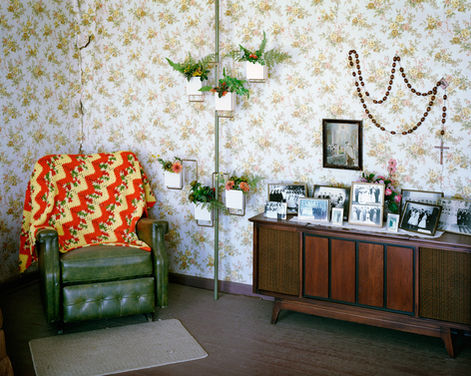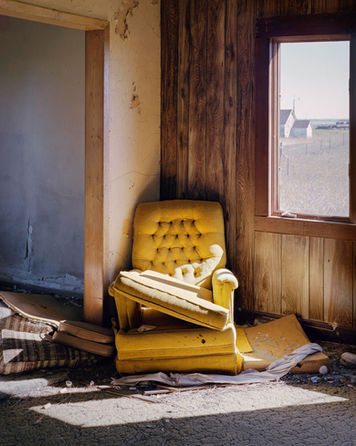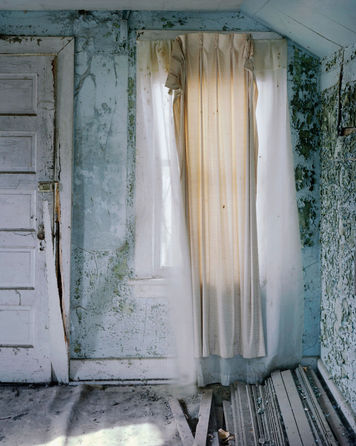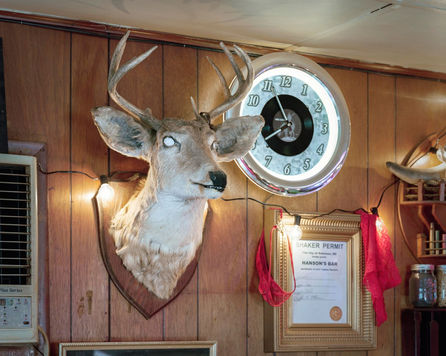Thank you for doing this interview Lewis. When I first reached out to you, I told you that your photography of the American Heartland reminded me, in many ways, of the Dutch countryside I grew up in. Although in terms of versatility in landscape it differentiates immensely, the population loss and the changing economics of the region seem almost universal components embedded in rural areas. Growing up in North Dakota and spending much of your life traveling throughout the American Midwest, I imagine you must have witnessed many changes firsthand. Could you share your backstory and speak a bit on how you have seen the regions change?
Thank you for your interest in my work and wanting to interview me! I grew up on a farm near the tiny town of Kensal, North Dakota. I have always had an interest in railroads and when I was still young would occasionally buy magazines geared towards railroad enthusiasts, such as Trains. At some point I discovered that all the photographs being published in the magazine were not staff photographers but amateurs (known as “railfans”) who submitted not only photos, but whole articles, and even got paid for their submissions. This was a bit of a revelation that anyone with a camera and a good eye could get published and I decided I’d try it. This was in about 1998 when I was in high school and how I got into photography.
Photographing railroads led to doing road trips around my area looking for new locations. While passing through all these small North Dakota towns I started photographing other things that looked interesting, just for the sake of documenting them. Eventually it turned out I was more interested in photographing these small towns than I was the railroads. This was purely a documentary approach, trying to preserve on film some of these towns as they appeared. Eventually in college I was introduced to photographers such as Robert Adams and Frank Gohlke and I began to apply more aesthetic elements to photography. It’s been a gradual evolution from creating a pure document to the type of photography I do now and I hope that my work continues to evolve.
Since I’ve been photographing small towns, primarily in North Dakota, for 25 years I’ve seen quite a few changes firsthand (though I think much more drastic changes occurred in the few decades just before I began photographing). There’s a lot of places I’ve photographed in the past that are just completely gone. Businesses I went into 20 years ago are vacant lots. In my own hometown I’ve seen the high school close and the grocery store shut down, and just recently the roof collapsed on the old grocery store building. Rural communities have been in decline for the past century as farming, the backbone of the rural economy, has changed from being extremely labor intensive to requiring fewer and fewer people to farm vastly more acreage. In addition most young people leave for better opportunities and excitement that just doesn’t exist in rural areas. As it’s happening the change is barely noticeable, but looking back 20-25 years it’s somewhat shocking to witness what has changed. It’s not all bad news though as some towns have stablilized in population or even gained a little, the result of young people wanting to get out of the cities and having the ability to do so because of the advent of working remotely. While rural America will never be what it once was there’s at least a glimmer that it won’t completely dry up and blow away.
In regard to this, I wonder whether these changes in time and space have influenced the perspective with which you capture life around you? Has it inspired you to become more aware of the socio-economic elements at play; utilizing photography as a form of storytelling?
One thing it’s made me aware of, don’t wait to photograph something! Even if the light’s not great, photograph it anyway. Too many times I’ve said “I’ll come back to photograph it when the light’s better” only to return and find it gone. This can even apply to people. If you have the chance to photograph, take it. I’m still working out how to best photograph the region and tell the story. It’s not necessarily an easy thing to do with photography. The whole of the story is so big and complex you can really only capture slices of it. It’s a part of my photography I’ll keep pursuing but I may never be able to really tell the whole story in pictures.
You recently released a long-term documentary project on the American Midwest. The captivating title, Driving Through Flyover Country, already alludes to the theme at hand, but could you elaborate on the intention and meaning behind it?
I’m not sure how well known the term “flyover country” is outside the USA. In case anyone is not familiar it’s a somewhat derogatory term given to the states between the east and west coast. The implication is these are areas that people just fly over on their way to somewhere more interesting, there’s nothing to really see there. The title is a bit of play on words that I actually like to drive through these regions most people fly over, and the project is meant to show there is something interesting to see here. It may not be cities, mountains, and oceans, but there’s something to see here if you look. Some of it is beautiful, some of it is ugly, and there’s a whole cast of characters that inhabit the place. This is what you miss if you simply fly over it.
When I was looking at several images of Driving Through Flyover Country, I was especially drawn to the somewhat contradicting emotions they managed to evoke: from intimacy to solitude and beauty to despair. Would you consider these juxtapositions as typical of the American Midwest; an area full of contradictions and surprises? A land of paradoxes?
Paradoxes maybe goes too far, but contradictions and surprises I would say is accurate. Sure there’s a lot of flat, empty landscapes, but they look completely different at different times of the year and different times of the day. If the elements all line up you’re given a landscape as beautiful as any mountain range or seascape, it’s just a bit different sort of beauty. Some places are managing to hold on pretty well economically while the next town over is basically a ghost town. Why one place survives and the other doesn’t is a bit of a mystery. Even the people are full of surprises, there is no one personality that inhabits the Midwest, it’s really diverse. And there are some real characters out there too! One guy I photographed in the book used to wrestle bears for fun. Another does incredible woodworking that would bring in thousands of dollars in a place like New York or LA, but he lives in rural Illinois and mostly does it just for the fun of doing it.
The book features a written text by Photographer Wayne Gudmundson. In the accompanying essay, he states the following: “The images that make up this project are not judgmental, nor are they sentimental or nostalgic. They do not grieve the passing of the rural life of his childhood, rather they are honest and of that place.” In capturing the honesty of the current as a photographer, how do you balance the act of mirroring reality and including artistic imperatives of taste and conscience?
I don’t think any photography, even the most well-meaning photojournalism, can capture a true reality. There’s alway decisions being made of what to include, what not to include, and when to release the shutter. That being said I tried to be pretty broad in what I photographed, including chain stores such as Dollar General or Rural King, because these are just as much about the Midwest in the current era as some of the more quaint and anachronistic places I also photographed. Where I tried to impart my artistic imperative was utilizing the light and choosing where to place the camera. Photographing a scene in good light or moving the camera to a different angle to make the elements line up is still capturing the reality of a place, just in a more artistic fashion. Regardless, I still made choices about what I photographed and what I didn’t which were purely subjective to my whims and interests. So in some ways the reality is actually the reality as I saw it. If someone else photographed the same project, the reality may be presented completely differently from what I created. As I stated before, the region is so large and complex it’s hard to capture with just photographs. So when I say reality as I saw it, I sort of mean it as a slice of the complex reality that exists.
Urban populations have been outgrowing rural populations since the 1920s, poverty rates are increasing, and a lack of health care, amenities and facilities are often reported as reasons for a decrease in Rural America. Although Driving Through Flyover Country manages to elevate the beauty in rural life, it also confronts the viewer with the realities of the Midwest. When creating this project, is this something you intentionally set out to do?
Yes, I really wanted to capture an array of rural life in the Midwest. I love photographing abandoned places, I could do nothing but that, but if I did so it would be a skewed look at the region. Closed businesses and abandoned buildings are a big part of the Midwest, but not the only part. There are still places making a go of it, and chain stores like Dollar General and Casey’s have a huge presence in the Midwest now, and are well patronized (often to the detriment of local businesses, leading to more abandoned buildings). I wanted to capture a little bit of each, what’s there and what was there. What I couldn’t figure out how to photograph though was things like people having to drive hours for anything more than basic health care, or even having to drive an hour just to get groceries. But it’s become a sort of way of life out here, people do this and don’t really think about it.
Although the images are not judgmental, nostalgic or sentimental in nature, the photographs of each place and face can allude to a variety of narratives and can elicit various emotions. When looking at Driving Through Flyover Country it becomes evident that it captures regions as they are, however, as a viewer it is difficult to consider present-day images without giving thought to the past. As a photographer who grew up in a rural environment, how do you deal with the interchange of these dynamics? Capturing contemporary landscapes that reveal details of its past?
I love history, most of what I read is non-fiction historical subjects. And most of the people living out here seem to be fascinated with history to some extent as well. Most people I encountered would be most energetic when talking about the history of their town. Unfortunately most of that history revolved around businesses, building, and people that disappeared decades ago. Maybe it’s how people (including myself) cope with what’s not there anymore, by remembering what was there. That sentiment probably finds its way into my photography, a present-day image where with some imagination you can imagine it in the past. At the same time I keep in mind that what I’m photographing today will be the past someday. Consider Stephen Shore’s Uncommon Places, at the time they were photographs of the ordinary, but almost 50 years on they’ve sort of become a historical document of a time and place unintentionally. What I struggle with most, actually, is photographing places that don’t have as much history, the common and the ordinary today. Eventually these places too will be history.
In this regard, do you think documenting the American Midwest could even be separated from the socio-economic concepts around these landscapes and the people experiencing them?
It depends on your approach to photography. I think it could be if you were interested purely in landscapes, or purely in shape or form. But it certainly isn’t easy. Once you begin including the human element of the Midwest (which is nearly all of it if you include farmland as a human element) it’s hard to separate socio-economic concepts from the landscape.
To some, photographs are expected to be idealized images. Both Driving Through Flyover Country and Abode of Iron Desolation seem to intentionally deviate from this notion. As a photographer (i.e. artist), can you share your view on the importance of diverging from painting a rosy picture?
I think it’s important to at least attempt to show things as they are. As I stated previously, I don’t think any photography can ever show things as they truly are, but I like to try to get closer to that. Anyone that’s spent a winter in North Dakota knows that it’s mostly long, dark, and cold. There’s also some really pleasant days, but those are the idealized photos the tourism department puts out. I’d like to show more of what it’s really like!
Although you spent much of your childhood and adult life in rural settings, there are many people who might not be acquainted with the multitude of places and faces rural life has to offer. Would it be fair to state your photography is partially motivated and inspired by capturing the beauty in the familiar? And as a result, challenging the viewer to see the beauty in, what to them might be, the unfamiliar?
As I stated in the first question I was motivated to try photography because anyone could submit photos to these magazines. One thing I noticed was there was virtually no coverage of my region, so one of the things I wanted to do was show people what it looks like out here (and I will say I had some success, having had several photos published in railroad magazines and a feature article in CTC Board in 2004). I think this same motivation has seeped over into my non-railroad work, I want to show people the area I’m familiar with because it doesn’t get much coverage. And having lived here most of my life I’m pretty familiar and comfortable with it. It’s easy to see beauty in a mountainscape or appreciate the architecture of a skyscraper; I want people to see the beauty in a wheatfield where the horizon is perfectly flat, or to appreciate the architecture of a grain elevator. I see it all the time, I’d love it for people who aren’t familiar with it to also see it.
In the opening question, I alluded to certain universal experiences of rural life. As I was scrolling through your blog I stumbled upon images of a softball game in Woodworth, North Dakota. Out of these images, there was one particular shot that featured people playing softball against a backdrop of a grain elevator. It somehow reminded me of an image I had seen of workers playing soccer against a backdrop of steel mills in the German Ruhr region. Despite the differences regarding time and space, they both manage to exuberate a certain essence of the power of communion, labor and leisure. Do you think, whether intentional or not, your photography perhaps serves as a testament to the many aspects of rural life, thus offering resemblances in lived experiences that are not defined by borders?
I was not familiar with that German photograph, but I can definitely see the parallels! I’d like my photographs to encompass the many aspects of rural life, even if I don’t always achieve that goal. I haven’t had many opportunities to travel outside the USA but having talked to people I know that have I get the feeling there’s a shared commonality between rural America and anywhere else rural in the world. Most face the same problems and most share the same experiences, and all differ from life in cities.
I noticed that your background is incredibly diverse, from having a Bachelor of Science in Graphic Communications and a Bachelor of Music in Jazz Performance to working as a locomotive engineer and continuing to pursue photographic subjects. Generally, do you think it is important to broaden one’s horizon (exploring different fields)? And how have these different proficiencies helped you in your pursuit of photography?
When I was a student of Wayne Gudmundson’s he sometimes referred to me as the “renaissance farm boy” due to my diversity of interests! I’m all for broadening horizons no matter what you do in life, it’s always going to give you new ways of seeing things if you’re open to it. For myself it’s helped a lot in photographing the Midwest. I find it much easier to open doors and connect with people if you can discuss things like railroading and farming and your shared experiences than if you did nothing but take pictures. Having that common ground to start with is nice for starting communication with strangers.
You are well acquainted with digital and film photography, but I saw you recently experimented with tintype photography. Could you speak on this experience? Furthermore, could you share your view on the importance of experimentation?
It was a very brief experiment. My friend Kent Staubus has been doing wet plate photography for quite a while and has a portable darkroom built into his car to allow doing it in the field. He was in my area this summer with his set up and let me give the process a try. It was pretty fascinating and since I’ve had various project ideas coming to mind utilizing wet plate (though I still haven’t convinced myself to jump into it just yet!). It definitely opens your eyes to what someone like William Henry Jackson went through to make photographs. In fact you wonder how he ever managed to produce photographs in the field! No matter what medium you work in, we have it so easy today!
For myself experimentation is nice because it keeps me from losing interest. After I stopped shooting Flyover Country I worked in film for a bit longer on another project but was starting to get frustrated with the limits, cost, and time of large format photography and started shooting more digital, which opens up many more opportunities and has breathed some fresh air into my photographic style. Perhaps once I start getting tired of this medium I’ll dive into wet plate!
As a final topic, I would like to delve a bit deeper into your own consumption of art. I often wonder about the influence of art on art and the influence artists (from varying disciplines) can have on one another. I personally believe it is important to be open towards other forms of art and to allow the differences to inspire. However, I am very curious to hear your take on this: Do you believe art can elevate art? And are you often motivated and inspired by other artists?
As part of my music education at Minnesota State University Moorhead I took several music history classes with Dr. Henry Gwiazda. Though he was technically a music professor I learned more about the visual art world in his classes than I ever did in any dedicated art classes. He tied the history of musical styles with other art styles taking place at the time and was able to clearly explain what the particular art movement was interested in. He’d give examples of visual arts in class and how they related to the music being produced at the time. This gave me a much better understanding of art as a whole, and introduced me to artists I may not have otherwise understood. Art can elevate art, no artist was ever working in a vacuum, any great artist is going to be influenced by artists working outside their own medium. I was particularly fascinated by the minimalist sculpture work of Donald Judd. I suspect some of his ideas in a broad sense have found their way into my photography! Edward Hopper is another non-photographic artist who has been an inspiration as well.
Additionally I find inspiration from films as well, especially the Coen Brothers. I’m sure it will come as no surprise that Fargo and No Country For Old Men both have and still do inspire me photographically. The landscape was as much a main character in each film as any of the actors and the way they captured it is perfect for the story being told. Like their films, the landscape is also a main character in my work.
To close out this interview, could you share with us some art and artists that have inspired you recently?
Just a few weeks ago I picked up two books that feature some phenomenal photographic work. One is The North Fork by Trent Davis Bailey just published by Trespasser, and the other is Rebecca Norris Webb’s My Dakota. Both feature photographs that are pure poetry in a single image. Alec Soth has often compared photographic projects to poetry, but each image from these two could be an entire poem in itself. These are just some recent inspirations, but my list of art and artists that inspire me could probably go on for pages!
Driving Through Flyover Country is available for purchase here. More images can be viewed below.


An interview with Lewis Ableidinger
Lewis Ableidinger is a photographer from Kensal, North Dakota. He recently released a long-term photographic project titled Driving Through Flyover Country. In this interview we talk about his rural upbringing, capturing the American Midwest, creative influences & more.
November, 2023



















